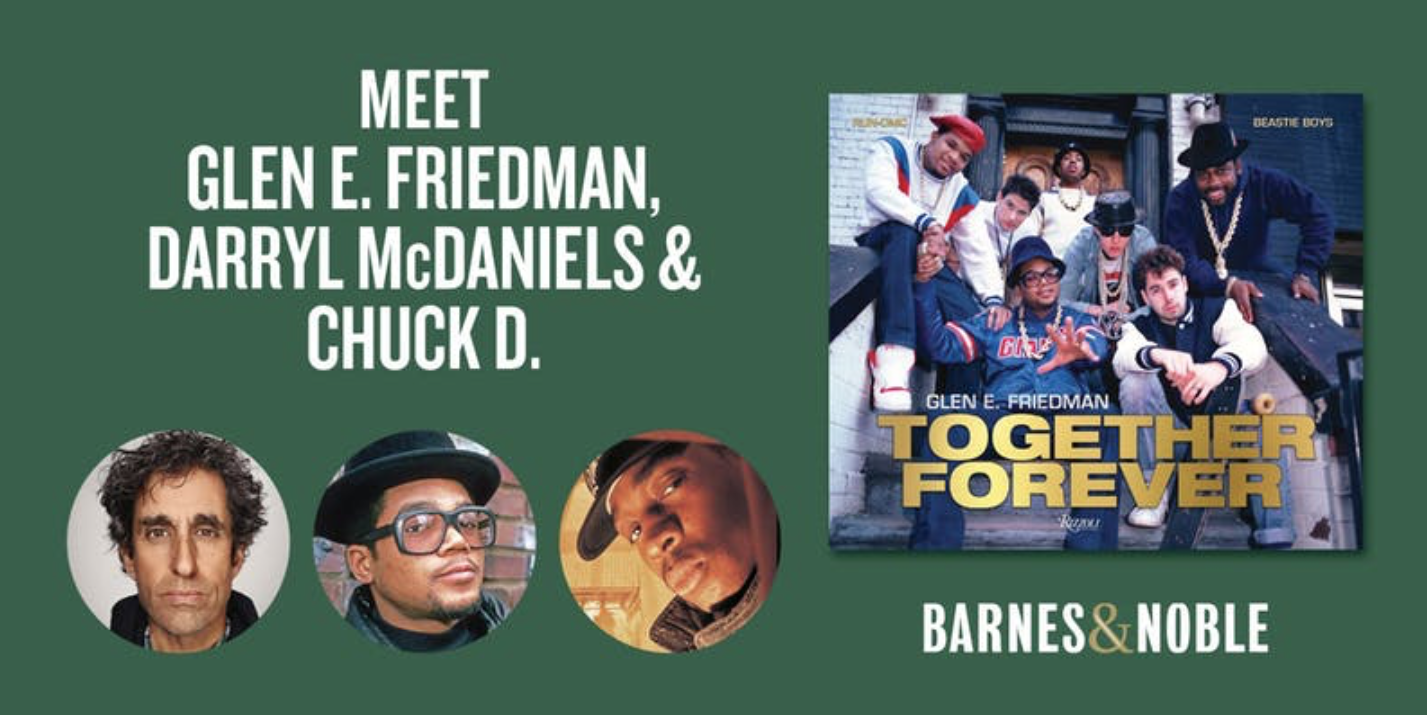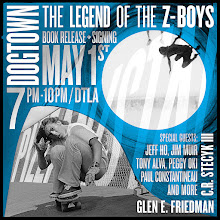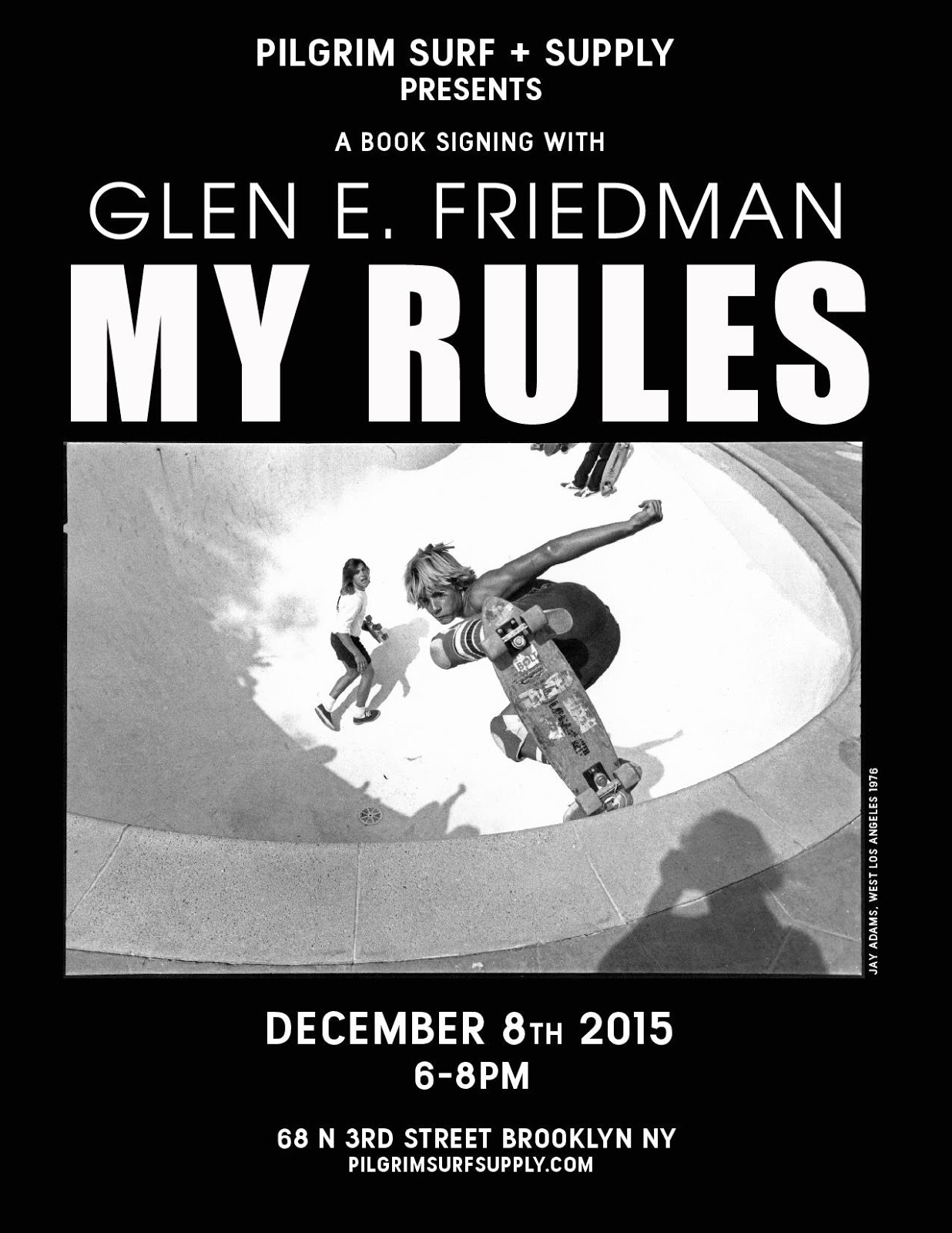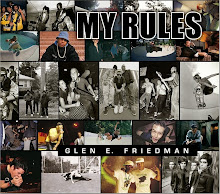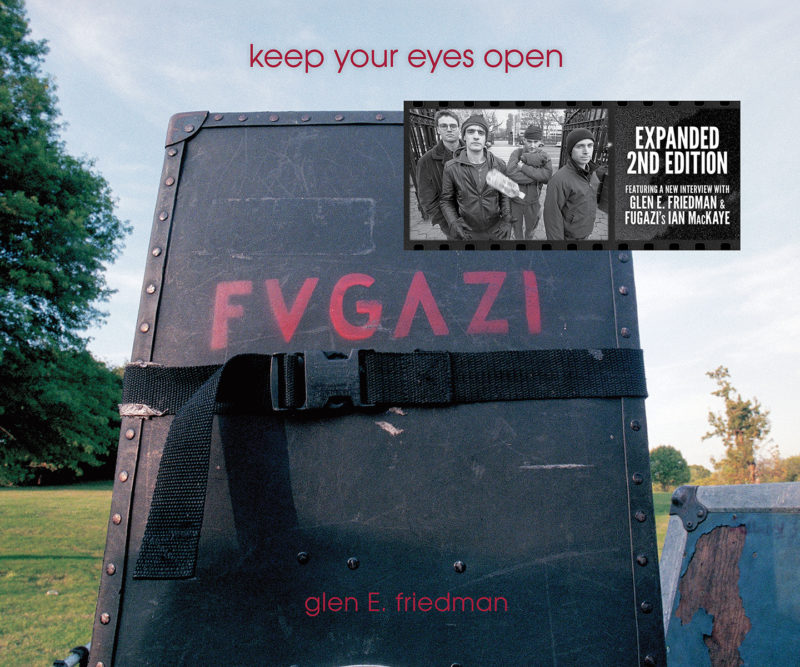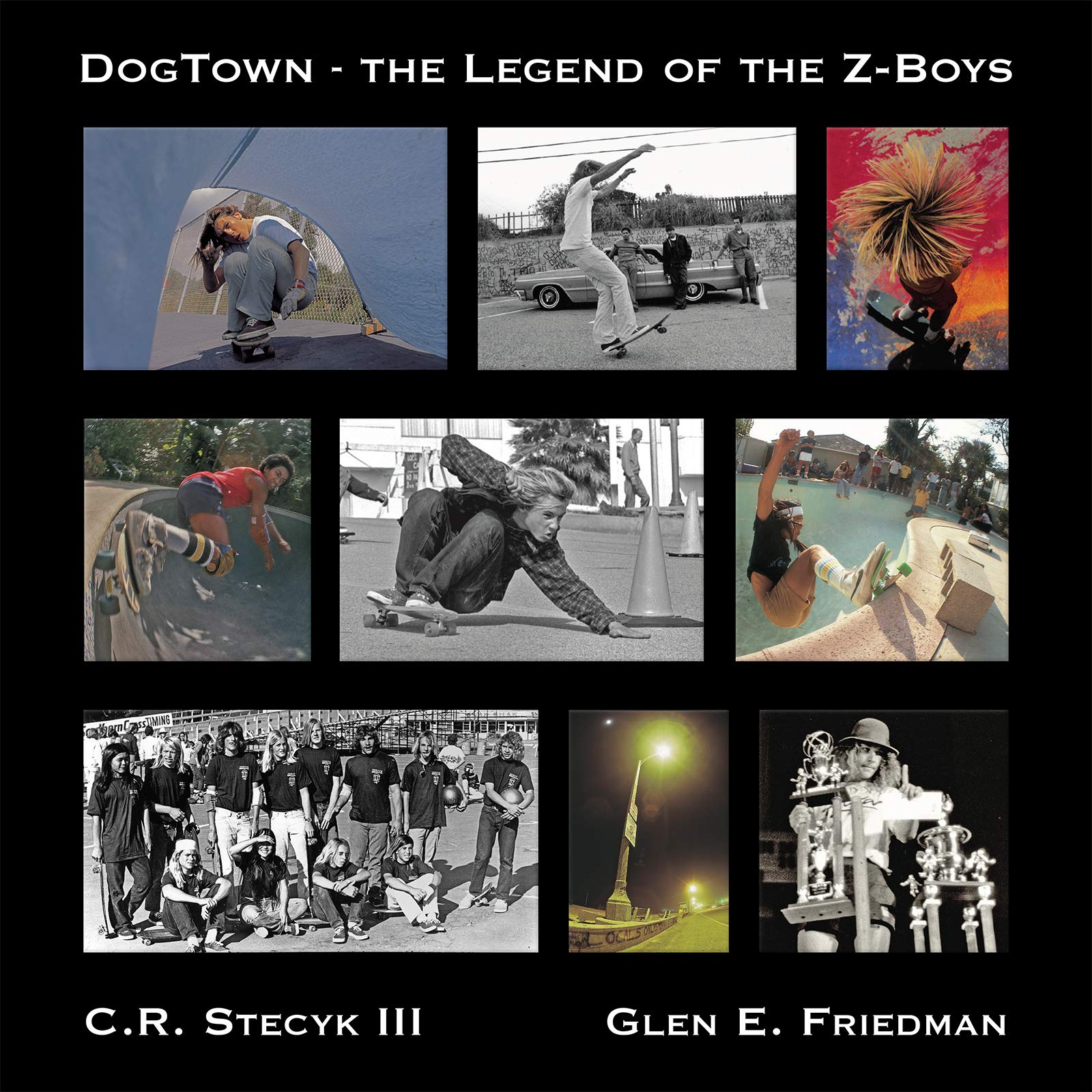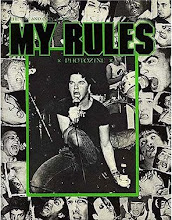Tuesday, March 31, 2015
Greatly produced Interview I did
at the opening of FUCK YOU ALL Dublin
with "State.ie" (Ireland, 2010)
"Glen E. Friedman – Pictures & Words" with Julien Clancy
This almost 12 minute video takes you on a journey through the work, with a selection of career defining shots, spanning four decades.
Interviewed by Julien Clancy
Produced and Directed by Julien Clancy
Edited by Mark Bennett
Special thanks to Aidan Kelly
Monday, March 30, 2015
Minor Threat Live at CBGB's 1982
(Horrible quality video) but some great photographs!
So for the first time, while not 'out of town', i am reposting a blog, because this one is just too good.
While the best of these MINOR THREAT photographs are printed HUGE in my latest book MY RULES, several of these images have never been published anywhere before - dig it! - GEF
Here's some video from the same insane afternoon:
same video a little darker but sharper, take your pick:
Good thing I was there to get these photographs:









Yes, there's an individual shot of each band member here including Steve for that brief period when Minor Threat were a 5-piece.

Sunday, March 29, 2015
Saturday, March 28, 2015
Minor Threat at CBGB's 1982
(horrible quality video) but great photos!
While the best of these Minor Threat photos are printed HUGE
in my latest book MY RULES, several of them have never been published anywhere before -
dig it! - GEF
and here's the video from the same insane afternoon:
same video a little darker but sharper, take your pick:
Good thing I was there to get these photographs:









Yes, there's an individual shot of each band member here including Steve for that brief period when Minor Threat were a 5-piece.

Friday, March 27, 2015
Enjoy the Design Genius of Saul Bass

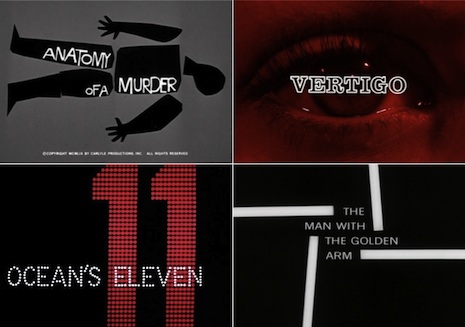
Over five decades Saul Bass designed opening title sequences that were sometimes better than the movies they introduced. His ambition he once said was to “make beautiful things even if nobody cares.”

Bass started out as a graphic designer and was asked by film director Otto Preminger to put together a poster for his movie Carmen Jones. Preminger was so impressed by the result that he asked Bass to design the opening titles. So began his 40-year career in movies. Bass went on to work with Preminger again on The Man with the Golden Arm and Anatomy of a Murder, he also designed titles for Alfred Hitchcock (Vertigo, Psycho), and Martin Scorsese (Cape Fear, The Age of Innocence and Casino).

Additionally, Bass designed the logos for a whole range of corporations and products and even had time to direct the cult science fiction movie Phase IV. As a designer he set a standard for other to follow, which is evident from this hour-long selection of his title work from 1955-1995.
Thursday, March 26, 2015
Noam Chomsky on the Roots of American Racism

from The New York Times
By George Yancy and Noam Chomsky
George Yancy: When I think about the title of your book “On Western Terrorism,” I’m reminded of the fact that many black people in the United States have had a long history of being terrorized by white racism, from random beatings to the lynching of more than 3,000 black people (including women) between 1882 and 1968. This is why in 2003, when I read about the dehumanizing acts committed at Abu Ghraib prison, I wasn’t surprised. I recall that after the photos appeared President George W. Bush said that “This is not the America I know.” But isn’t this the America black people have always known?
Noam Chomsky: The America that “black people have always known” is not an attractive one. The first black slaves were brought to the colonies 400 years ago. We cannot allow ourselves to forget that during this long period there have been only a few decades when African-Americans, apart from a few, had some limited possibilities for entering the mainstream of American society.
We also cannot allow ourselves to forget that the hideous slave labor camps of the new “empire of liberty” were a primary source for the wealth and privilege of American society, as well as England and the continent. The industrial revolution was based on cotton, produced primarily in the slave labor camps of the United States.
As is now known, they were highly efficient. Productivity increased even faster than in industry, thanks to the technology of the bullwhip and pistol, and the efficient practice of brutal torture, as Edward E. Baptist demonstrates in his recent study, “The Half Has Never Been Told.” The achievement includes not only the great wealth of the planter aristocracy but also American and British manufacturing, commerce and the financial institutions of modern state capitalism.
It is, or should be, well-known that the United States developed by flatly rejecting the principles of “sound economics” preached to it by the leading economists of the day, and familiar in today’s sober instructions to latecomers in development. Instead, the newly liberated colonies followed the model of England with radical state intervention in the economy, including high tariffs to protect infant industry, first textiles, later steel and others.
There was also another “virtual tariff.” In 1807, President Jefferson signed a bill banning the importation of slaves from abroad. His state of Virginia was the richest and most powerful of the states, and had exhausted its need for slaves. Rather, it was beginning to produce this valuable commodity for the expanding slave territories of the South. Banning import of these cotton-picking machines was thus a considerable boost to the Virginia economy. That was understood. Speaking for the slave importers, Charles Pinckney charged that “Virginia will gain by stopping the importations. Her slaves will rise in value, and she has more than she wants.” And Virginia indeed became a major exporter of slaves to the expanding slave society.
Some of the slave-owners, like Jefferson, appreciated the moral turpitude on which the economy relied. But he feared the liberation of slaves, who have “ten thousand recollections” of the crimes to which they were subjected. Fears that the victims might rise up and take revenge are deeply rooted in American culture, with reverberations to the present.
The Thirteenth Amendment formally ended slavery, but a decade later “slavery by another name” (also the title of an important study by Douglas A. Blackmon) was introduced. Black life was criminalized by overly harsh codes that targeted black people. Soon an even more valuable form of slavery was available for agribusiness, mining, steel — more valuable because the state, not the capitalist, was responsible for sustaining the enslaved labor force, meaning that blacks were arrested without real cause and prisoners were put to work for these business interests. The system provided a major contribution to the rapid industrial
development from the late 19th century.
That system remained pretty much in place until World War II led to a need for free labor for the war industry. Then followed a few decades of rapid and relatively egalitarian growth, with the state playing an even more critical role in economic development than before. A black man might get a decent job in a unionized factory, buy a house, send his children to college, along with other opportunities. The civil rights movement opened other doors, though in limited ways. One illustration was the fate of Martin Luther King’s efforts to confront northern racism and develop a movement of the poor, which was effectively blocked.
The neoliberal reaction that set in from the late ‘70s, escalating under Reagan and his successors, hit the poorest and most oppressed sectors of society even more than the large majority, who have suffered relative stagnation or decline while wealth accumulates in very few hands. Reagan’s drug war, deeply racist in conception and execution, initiated a new Jim Crow, Michelle Alexander’s apt term for the revived criminalization of black life, evident in the shocking incarceration rates and the devastating impact on black society.
Reality is of course more complex than any simple recapitulation, but this is, unfortunately, a reasonably accurate first approximation to one of the two founding crimes of American society, alongside of the expulsion or extermination of the indigenous nations and destruction of their complex and rich civilizations.
G.Y.: While Jefferson may have understood the moral turpitude upon which slavery was based, in his “Notes on the State of Virginia,” he says that black people are dull in imagination, inferior in reasoning to whites, and that the male orangutans even prefer black women over their own. These myths, along with the black codes following the civil war, functioned to continue to oppress and police black people. What would you say are the contemporary myths and codes that are enacted to continue to oppress and police black people today?
N.C.: Unfortunately, Jefferson was far from alone. No need to review the shocking racism in otherwise enlightened circles until all too recently. On “contemporary myths and codes,” I would rather defer to the many eloquent voices of those who observe and often experience these bitter residues of a disgraceful past.
Perhaps the most appalling contemporary myth is that none of this happened. The title of Baptist’s book is all too apt, and the aftermath is much too little known and understood.
There is also a common variant of what has sometimes been called “intentional ignorance” of what it is inconvenient to know: “Yes, bad things happened in the past, but let us put all of that behind us and march on to a glorious future, all sharing equally in the rights and opportunities of citizenry.” The appalling statistics of today’s circumstances of African-American life can be confronted by other bitter residues of a shameful past, laments about black cultural inferiority, or worse, forgetting how our wealth and privilege was created in no small part by the centuries of torture and degradation of which we are the beneficiaries and they remain the victims. As for the very partial and hopelessly inadequate compensation that decency would require — that lies somewhere between the memory hole and anathema.
Jefferson, to his credit, at least recognized that the slavery in which he participated was “the most unremitting despotism on the one part, and degrading submissions on the other.” And the Jefferson Memorial in Washington displays his words that “Indeed I tremble for my country when I reflect that God is just: that his justice cannot sleep forever.” Words that should stand in our consciousness alongside of John Quincy Adams’s reflections on the parallel founding crime over centuries, the fate of “that hapless race of native Americans, which we are exterminating with such merciless and perfidious cruelty...among the heinous sins of this nation, for which I believe God will one day bring [it] to judgment.”
What matters is our judgment, too long and too deeply suppressed, and the just reaction to it that is as yet barely contemplated.
G.Y.: This “intentional ignorance” regarding inconvenient truths about the suffering of African- Americans can also be used to frame the genocide of Native Americans. It was 18th century Swedish taxonomist Carolus Linnaeus who argued that Native Americans were governed by traits such as being “prone to anger,” a convenient myth for justifying the need for Native Americans to be “civilized” by whites. So, there are myths here as well. How does North America’s “amnesia” contribute to forms of racism directed uniquely toward Native Americans in our present moment and to their continual genocide?
N.C.: The useful myths began early on, and continue to the present. One of the first myths was formally established right after the King of England granted a Charter to the Massachusetts Bay Colony in 1629, declaring that conversion of the Indians to Christianity is “the principal end of this plantation.” The colonists at once created the Great Seal of the Colony, which depicts an Indian holding a spear pointing downward in a sign of peace, with a scroll coming from his mouth pleading with the colonists to “Come over and help us.” This may have been the first case of “humanitarian intervention” — and, curiously, it turned out like so many others.
Years later Supreme Court Justice Joseph Story mused about “the wisdom of Providence” that caused the natives to disappear like “the withered leaves of autumn” even though the colonists had “constantly respected” them. Needless to say, the colonists who did not choose “intentional ignorance” knew much better, and the most knowledgeable, like Gen. Henry Knox, the first secretary of war of the United States, described “the utter extirpation of all the Indians in most populous parts of the Union [by means] more destructive to the Indian natives than the conduct of the conquerors of Mexico and Peru.”
Knox went on to warn that “a future historian may mark the causes of this destruction of the human race in sable colors.” There were a few — very few — who did so, like the heroic Helen Jackson, who in 1880 provided a detailed account of that “sad revelation of broken faith, of violated treaties, and of inhuman acts of violence [that] will bring a flush of shame to the cheeks of those who love their country.” Jackson’s important book barely sold. She was neglected and dismissed in favor of the version presented by Theodore Roosevelt, who explained that “The expansion of the peoples of white, or European, blood during the past four centuries...has been fraught with lasting benefit to most of the peoples already dwelling in the lands over which the expansion took place,” notably those who had been “extirpated” or expelled to destitution and misery.
The national poet, Walt Whitman, captured the general understanding when he wrote that “The nigger, like the Injun, will be eliminated; it is the law of the races, history... A superior grade of rats come and then all the minor rats are cleared out.” It wasn’t until the 1960s that the scale of the atrocities and their character began to enter even scholarship, and to some extent popular consciousness, though there is a long way to go.
That’s only a bare beginning of the shocking record of the Anglosphere and its settler-colonial version of imperialism, a form of imperialism that leads quite naturally to the “utter extirpation” of the indigenous population — and to “intentional ignorance” on the part of beneficiaries of the crimes.
G.Y.: Your response raises the issue of colonization as a form of occupation. James Baldwin, in his 1966 essay, “A Report from Occupied Territory,” wrote, “Harlem is policed like occupied territory.” This quote made me think of Ferguson, Mo. Some of the protesters in Ferguson even compared what they were seeing to the Gaza Strip. Can you speak to this comparative discourse of occupation?
N.C.: All kinds of comparisons are possible. When I went to the Gaza Strip a few years ago, what came to mind very quickly was the experience of being in jail (for civil disobedience, many times): the feeling, very strange to people who have had privileged lives, that you are totally under the control of some external authority, arbitrary and if it so chooses, cruel. But the differences between the two cases are, of course, vast.
More generally, I’m somewhat skeptical about the value of comparisons of the kind mentioned. There will of course be features common to the many diverse kinds of illegitimate authority, repression and violence. Sometimes they can be illuminating; for example, Michelle Alexander’s analogy of a new Jim Crow, mentioned earlier. Often they may efface crucial distinctions. I don’t frankly see anything general to say of much value. Each comparison has to be evaluated on its own.
G.Y.: These differences are vast and I certainly don’t want to conflate them. Post-911 seems to have ushered in an important space for making some comparisons. Some seem to think that Muslims of Arab descent have replaced African-Americans as the pariah in the United States. What are your views on this?
N.C.: Anti-Arab/Muslim racism has a long history, and there’s been a fair amount of literature about it. Jack Shaheen’s studies of stereotyping in visual media, for example. And there’s no doubt that it’s increased in recent years. To give just one vivid current example, audiences flocked in record-breaking numbers to a film, described in The New York Times Arts section as “a patriotic, pro-family picture,” about a sniper who claims to hold the championship in killing Iraqis during the United States invasion, and proudly describes his targets as “savage, despicable, evil ... really no other way to describe what we encountered there.” This was referring specifically to his first kill, a woman holding a grenade when under attack by United States forces.
What’s important is not just the mentality of the sniper, but the reaction to such exploits at home when we invade and destroy a foreign country, hardly distinguishing one “raghead” from another. These attitudes go back to the “merciless Indian savages” of the Declaration of Independence and the savagery and fiendishness of others who have been in the way ever since, particularly when some “racial” element can be invoked — as when Lyndon Johnson lamented that if we let down our guard, we’ll be at the mercy of “every yellow dwarf with a pocket knife.” But within the United States, though there have been deplorable incidents, anti-Arab/Muslim racism among the public has been fairly restrained, I think.
G.Y.: Lastly, the reality of racism (whether it’s anti-black, anti-Arab, anti- Jewish, etc.) is toxic. While there is no single solution to racism, especially in terms of its various manifestations, what do you see as some of the necessary requirements for ending racist hatred?
N.C.: It’s easy to rattle off the usual answers: education, exploring and addressing the sources of the malady, joining together in common enterprises — labor struggles have been an important case — and so on. The answers are right, and have achieved a lot. Racism is far from eradicated, but it is not what it was not very long ago, thanks to such efforts. It’s a long, hard road. No magic wand, as far as I know.
This interview was conducted by email and edited. Previous interviews in this series (with Linda Martin Alcoff, Judith Butler, Joy James, Charles Mills, Falguni A. Sheth, Shannon Sullivan and Naomi Zack) can be found here.© 2015 The New York Times Company
George Yancy is a professor of philosophy at Duquesne University. He has written, edited and co-edited numerous books, including “Black Bodies, White Gazes,” “Look, a White!” and “Pursuing Trayvon Martin,” co-edited with Janine Jones.
Wednesday, March 25, 2015
Tuesday, March 24, 2015
Monday, March 23, 2015
Sunday, March 22, 2015
Cornel West:
I am a hater... of injustice
Around the world the election of Barak Obama to the White House was seen as a watershed moment for race relations in America.
The first black man to be president was taken as the symbol of a new post-racial era.
But six years on, with tensions between black communities and the police running sky high is anyone still talking about a post racial America?
HARDtalk speaks to Cornel West, writer, academic and fierce critic of President Obama and asks why the race debate turned sour.
He tells Stephen Sackur: "I hate Barack Obama's policies. I hate his deeds. I hate his cowardice. I hate his acts. I love him as a human being."
Saturday, March 21, 2015
After the Kodak Moment
A New York Times short video
BY Colin Archdeacon and John Woo | Mar. 20, 2015 | 5:33
Kodak has prioritized its patent portfolio and the Eastman Business Park since it declared bankruptcy in 2012. Despite some success, the company might never live up to the legacy of its own past.
pretty fucking sad for people who still shoot film, as I still do...
Friday, March 20, 2015
SkateBoarding Hall of Fame inductees for 2015
Have been Announced!
CONGRATULATIONS TO ALL!
Honored to have shot these folks when i did...

Duane Peters

Chris Miller

Neil Blender

Cara beth Burnside as a little kid
Ballots went out to nearly 400 qualified representatives from all eras of skateboarding history to vote for their choice for the Class of 2015 Hall of Fame inductions. We're happy to report the results after a week of vote collection!
2015 Inductees:
1960s Brian Logan
1970s Era One - Henry Hester
1970s Era Two - Duane Peters
1980s Era One - Neil Blender
1980s Era Two - Chris Miller
1990s John Cardiel
1970s Female - Robin Logan
1980s Female - Cara-Beth Burnside
1990s Female - Elissa Steamer
2015 Icon Awards: TBA
We hope you can join us on May 14th, 2015 at the Westin South Coast Plaza Hotel in Costa Mesa, CA for the 6th Annual Skateboarding Hall of Fame Induction Ceremony.
For tickets or hotel rooms visit: https://2015-shof.eventbrite.com
Sincerely,
Executive Director Emeritus | IASC
International Association of Skateboard Companies
Thursday, March 19, 2015
Wednesday, March 18, 2015
Ice-T speaks at Sing Sing on Ted Talks
Another great talk for y'all this week:
Tuesday, March 17, 2015
Skateboarding in Ethiopia
spreading confidence and individuality as well as brotherhood... this bug keeps on moving thorough the world... Skateboarding is fucking awesome!
Monday, March 16, 2015
Sunday, March 15, 2015
Saturday, March 14, 2015
THE DAMNED: Documentary
coming soon! (trailer)

British punk icons the Damned are the subject of a new documentary called The Damned: Don't You Wish That We Were Dead. It was directed by Wes Orshoski (co-director/producer of the documentary Lemmy) and will premiere on March 18 at SXSW. (The film will premiere at the Paramount Theatre; the Damned will perform at Mohawk later that night.)
Below, watch the trailer for the film. It features Mick Jones (the Clash), Keith Morris (OFF!/Black Flag/Circle Jerks), Lemmy Kilmister (Motörhead), Fred Armisen, Chrissie Hynde (the Pretenders), Duff McKagan (Guns N' Roses), Steve Diggle (the Buzzcocks), and others. Watch it below.
The film also features interviews with Ian MacKaye (Fugazi/Minor Threat), Nick Mason (Pink Floyd), Chris Stein and Clem Burke (Blondie), Buzz Osborne (the Melvins), and more.
Official trailer for the film THE DAMNED: Don't You Wish That We Were Dead, the authorized documentary of the punk pioneers. Directed/produced by Wes Orshoski (co-director/producer of "LEMMY"), the film features all four original members of the Damned (Captain Sensible, Dave Vanian, Brian James and Rat Scabies), plus appearances by Chrissie Hynde (Pretenders), Mick Jones (The Clash), Steve Diggle (Buzzcocks), actor/comedian Fred Armisen, Nick Mason (Pink Floyd), Duff McKagan (Guns N Roses), Lemmy Kilmister (Motorhead), Jack Grisham (T.S.O.L.), Keith Morris (Black Flag/Circle Jerks/OFF!), Dexter Holland (The Offspring) and many more. Shot around the world over the past four years, the film makes its debut at SXSW in March 2015. The third prong in the holy trinity of UK punk, with the Sex Pistols and the Clash, The Damned were the first U.K. punks to release a single ("New Rose") and album ("Damned Damned Damned"), and the first to tour the U.S. Having logged hits in the punk, new wave and goth eras, they are one of the only surviving bands from punk’s first wave.
Friday, March 13, 2015
Skateboarding in Palestine
a short doc.
Another testament to how skateboarding is fucking awesome.
from NOWNESS.com Shorts:
Journey to the Middle East with the inspirational SkatePal team
Over the past two years SkatePal, a Scotland-based charity, has built three parks across Palestine to help nurture a local skate community by teaching young kids the joy of skateboarding. Photographer and filmmaker Sirus F Gahan traveled to Gaza with fellow skaters and volunteers Luke Murphy, Martin O’Grady, Harry Gerrard and Sam Dearden to document SkatePal’s admirable work.
“As far as I have heard they were the first skaters in the country”
"We only met a handful of skaters on our first trip and they had just started skating about six months before," says Charlie Davis, who founded the charity after volunteering as a teacher in Jenin, in the northern West Bank, and later this year will build a skatepark in Asira ash-Shamaliya. "As far as I have seen and heard they were the first skaters in the country. Probably the most important part of what SkatePal does is publicize the skating scene in Palestine, so that people hear about it and go across to check it out."
What inspires you about SkatePal?
Sirus F Gahan: The idea of it being a completely new ground in Palestine really excited me. Being able to help bring over an activity to a troubled land, which has transformed and directed the lives of so many people that I know, then seeing the effect it has over there.
How were the reactions to you shooting a skate film in Palestine?
SFG: The actual act of skating is made so much easier by the fact that almost everyone you come across is super hyped on seeing you fly around on a piece of wood with wheels. The people are very kind and hospitable, so you'll often be offered food, water or sweet coffee whilst sessioning outside somebody's house. Pretty unimaginable concept in the Western skate world.
What were the skate spots like?
SFG: There are incredible hills, with which the asphalt has been fairly well maintained, so hill bombing is a pretty non-stop activity. There are spots all over the place as long as you have the right eyes to see them.
SKATEPAL
Click to donate and to support SkatePal
Charity Number: SC044815
Thursday, March 12, 2015
McDonald's sues to block Seattle's minimum wage

They're basing their case on the 14th Amendment, which addressed slavery by guaranteeing all persons equal protection under the law, and since corporations are people, well...But what about the equal protection rights of the people who work in these businesses? Our historical research has found that the drafters of the Fourteenth Amendment were very interested in employer-employee relations, and in particular, whether workers could earn "fair, living wages." That phrase doesn't come from some union organizer or activist in Seattle: it comes from Senator Jacob Howard, a staunch Republican who was the Fourteenth Amendment's Senate floor manager back in 1866, and whose statements on the concerns motivating the Fourteenth Amendment are a little more important than the legal opinions of Grimace and Captain Crook. And during the Congressional hearings documented in the official report of the committee that proposed the amendment, Senator Howard asked over and over whether employers would pay "fair, living wages." Of course, a living wage wasn't the only concern behind the Fourteenth Amendment. But, unlike protection of the franchised business model, it was definitely part of the overall goals.
Given how important the idea of "fair, living wages" was to the authors of the Fourteenth Amendment, it's shameful for the McNugget Buddies to claim that the Constitution's Equal Protection Clause should protect them, rather than real human workers with families to feed. But it's not surprising. Ever since the Fourteenth Amendment was passed, corporate lawyers have tried to leverage it into a racket to strike down laws like Seattle's. In 1938, a frustrated Supreme Court justice complained that "of the cases in [the] Court in which the Fourteenth Amendment was applied during the first fifty years after its adoption, less than one-half of 1 percent invoked it in protection of the negro race, and more than 50 percent asked that its benefits be extended to corporations." Just this past year, we've seen the Equal Protection Clause invoked on behalf of coal companies and multinational agribusiness conglomerates. And now, the Fry Kids.
Ronald McDonald and Friends Sue Seattle to Stop Minimum Wage Hike [Ron Fein/Huffington Post]
Wednesday, March 11, 2015
One Man Holds a Patent That Could Crush Monsanto and Change The World!

Humanity is facing a a major crisis: our immediate environment is being riddled with pesticides, making us unhealthy faster than we can study the effects. In addition, these pesticides are contributing to a massive reduction in our bee population and a general decline in soil health.
The companies that profit from making these pesticides have made it clear they won’t stop, and our petitions to the EPA and FDA are mostly ignored due to revolving door leadership between pesticide makers and government regulators. Is there an answer? Yes there is!SMART PesticidesPaul Stamets, the world’s leading mycologist, filed a patent in 2001 that was intentionally given little attention. In the words of pesticide industry executives, this patent represents “The most disruptive technology that we have ever witnessed.”
The biopesticides described in the patent reveals a near permanent, safe solution for over 200,000 species of insects, and it all comes from a mushroom. After what is called “sporulation” of a select entomopathogenic fungi (fungi that kill insects), the area becomes unsuitable for whatever insect(s) the fungi are coded for. Additionally, extracts of the entomopathogenic fungi can steer insects in different directions.
This is literally a complete paradigm shift away from the entire idea of pesticides. Instead of aiming to kill all problematic insects, a farmer could simply disperse a solution of pre-sporulation fungi among his or her crops. The insects would then simply live their lives around the crops, paying no attention to them. This simple idea flies in the face of the current, poorly thought out practice of spraying ever-increasing amounts of pesticides on resistant bugs. Going further, this biopesticide would also eliminate the need for round-up ready GMO seeds and BT seeds that grow the pesticides in the crop and which needlessly endanger us, the consumer, in the process. Perhaps the most enticing element of this biopesticide fungi is that it’s essentially free. According to the patent, it can be “cultivated on agricultural waste.” We are looking at a 100% safe, natural technology that literally can end all GMO and pesticide manufacturers overnight with a new class of SMART Pesticides.“The matrix of pre-sporulating fungi can optionally be dried, freeze-dried, cooled and/or pelletized and packaged and reactivated for use as an effective insect attractant and/or biopesticide.” – Paul Stamets Patent for Mycoattractants and MycopesticidesOptimism EmpowersEven if we stop pesticide spraying now, scores of new research is confirming that our environment, food, soil, and bodies already carry traces of the chemicals. If the chemicals are so bad for us, there would be signs by now, right? These is a common rebuttal from pesticide companies and individuals who don’t care to do their research. Well, there just happens to be a patent to help with those issues as well. The US patent filed in 2003, once again from Paul Stamets, describes the utilization of a fungal delivery system for the purpose of“ecological rehabilitation and restoration, preservation and improvement of habitats, bioremediation of toxic wastes and polluted sites, filtration of agricultural, mine and urban runoff, improvement of agricultural yields and control of biological organisms.”In addition, many people out there are currently providing solutions to remove/detox any potential pesticide chemicals from the human body. Strategies like community gardens, urban forests, and the resurgence of permaculture are springing up rapidly to pave the way towards a steadily growing number of pesticide-free dinner tables and families.Time to Make HistoryOn a larger scale, GMO food and pesticides are merely symptoms of an opposing consciousness that is rapidly changing. Put another way, these symptoms are the unwanted gifts from out of control corporations that, by definition, have no empathy towards the needs, health, or life of The People. As Neil Young mentioned in his Starbucks Boycott, pesticide companies like Monsanto are, for the most part, not public-facing companies. As we are witnessing now with GMO brands, a boycott can severely damage their bottom line (lifeblood) but will not eliminate their business model. Due to the fact that they spend untold millions lobbying (purchasing) our politicians and regularly operate revolving doors between public and private positions, only a paradigm shift will eliminate the entire industry. At that moment, which is approaching, pesticide manufacturers can decide if they would like to cease being the problem and assist in the solution.
The good news is that whatever decision they choose won’t matter. A shift in consciousness around pesticide and GMO use eliminates their influence and knocks them off their fictitious monetary pedestals they believe to be sitting on.
Tuesday, March 10, 2015
Monday, March 9, 2015
Leonard Nimoy fought for pay equity for Nichelle Nichols

Just in case you needed more reasons to miss the recently departed Leonard Nimoy: Last year, the website TrekMovie reported that during the filming of the original Star Trek series in the 1960s, Nimoy fought for pay equity for Nichelle Nichols, who played Uhura. The revelation came courtesy of Walter Koenig, the actor who played Chekov.Koenig: When it came to the attention of the cast that there was a disparity in pay in that George [Takei] and I were getting the same pay but Nichelle was not getting as much, I took it to Leonard and he took it to the front office and they corrected that.He will be missed.
Sunday, March 8, 2015
80 Blocks From Tiffany's
(Full Unedited Version)
This 1979 documentary film focuses on gangs such as the savage skulls & nomads who occupied areas of the south bronx. Perhaps even more compelling is considering that the backdrop and social conditions in this film are a 'far cry' from the lifestyle being promoted through disco music and film. Perhaps this answers questions to why many people took preference over the funk records which arguably pathed the way for Hip Hop culture.
Saturday, March 7, 2015
Flyin' Cut Sleeves
Full Documentary
A teachers look at the 70's gangs of New York
“Flyin’ Cut Sleeves” presents alternating portrayals, from the past and the present, of former street gang presidents in the Bronx. The project grew out of the experiences of Rita Fecher, the film’s co-producer, who taught in a South Bronx school in the late 1960′s and early 1970′s, became intimately involved with the gangs, their leaders, and the leaders’ families and began to document their lives.
Friday, March 6, 2015
Ian Svenonius:
Modern Pop Music Is ‘The Voice Of Wall Street’
from "Bandwidth"

photo above of the Make Up circa '95 (GEF)
Chain & the Gang leader Ian Svenonius has a new record out: the self-titled debut of XYZ
Ian Svenonius is one of D.C.’s most magnetic frontmen. He’s also an admitted rock ‘n’ roll despot.
The former vocalist for Nation of Ulysses, The Make-Up, Weird War and Scene Creamers has been on an anti-freedom kick for years. The 2009 debut from his now-main band, Chain & the Gang, was called Down With Liberty… Up With Chains! A song on its third LP, In Cool Blood, chanted, “I don’t believe in free will!” And this fall, Akashic Books publishes Svenonius’ latest book, titled Censorship Now!
xyz-radical-eliteBut Svenonius doesn’t practice much self-censorship, at least not when it comes to art. Right now, he’s got several creative outlets — a solo act called Escape-ism, various speaking engagements and writing ventures, regular gigs with Chain & the Gang and now, a (somewhat) new record: XYZ, his one-off synth project with France-based rocker Memphis Electronic.
The self-titled album first came out last year on Memphis Electronic’s label, Mono-Tone, and today Svenonius drops a limited edition on his own imprint, Radical Elite.
XYZ contains 10 tracks, most of them skeletal and sermonlike, with Svenonius fully in character. “Everybody wants to be poor,” he intones on the record’s eighth track. “But some people are rich. They can’t help it. That’s just the way they were born. Don’t judge them.”
It’s not always easy to square Svenonius’ philosophies when he vacillates between sincere and provocative, as I was reminded when I spoke to him on the phone Monday. He moves easily from decrying gentrification as “undemocratic” to calling himself “anti-democracy.” But Svenonius seems ever-strict on the idea of artistic value, and the importance of preserving what he thinks is left of it.
This interview has been edited for clarity and length.
Bandwidth: Tell me about XYZ and when you started getting that together.
Ian Svenonius: When I play in France, I sometimes get to play with my friend’s band, my friend Didier [Balducci], aka Memphis Electronic. I’ve played with his band over the years, and one of them is this group Non! I’ve toured with them and I toured with another one of his groups called Dum Dum Boys, which are an historic French band. He lives in Nice, the French Riviera… the Cote d’Azur. It’s kind of like the Florida of France. It’s right-wing and beautiful. And weird, ’cause I think it’s a tax haven for English rock stars and stuff. And Monaco’s right there.
So he lives down there and it’s kind of anomalous because there’s not a lot of cool culture happening. The French don’t think of it as very cool. So it just seemed interesting to go down there and work with him on some songs. We have similar tastes, but maybe he’s more sophisticated than I am. He played with Kim Fowley, his bands played with Johnny Thunders back in the day.
You know, the French, they just love pointy shoes. Everything’s gotta have a little bit of sexy. They’re kind of like naturally camp, the French. They have a very particular perspective on rock ‘n’ roll and I think it’s interesting.
On this record, you have 10 interludes. What is the utility of the interlude?
Its supposed to create the ambience of being in an arcade. Didier is like a pinball champion in France, and there’s a little town that we visited right across the border right near Monaco in Italy. There’s just a lot of pinball and arcades down there because it’s a beach town. So the idea was just to create this ambience of a pinball arcade.
Wait, Didier is a pinball champion?
He’s a champion. I mean he’s not the champion. But he’s a pinball champion.
You always have so much going on. How do you keep track of all your ideas?
Did you ever see that Woody Allen movie [Crimes and Misdemeanors] where Alan Alda walks around with a dictaphone?
Yes!
“Idea for sitcom!” [Laughs] No, I don’t know… I think you have to write things down or record them, and then you can always go back to them when you’re feeling stuck.
Do you really do that — record your ideas into your phone?
Oh yeah, sure, of course. Or you just write ‘em down. It’s so sad what they do to these people, though, these people they excavate your journal, like Kurt Cobain. Think of how horrible that is. Can you imagine that? Someone publishing your notes? That’s so disrespectful. Whatever scumbag vampire did that should really be haunted eternally. But it’s normal — it’s the treatment the artists get.
Are you worried that someone is going to find your thoughts one day? Ones that you didn’t want publicized?
No. I’m not too worried. First you have to have success.
“Right now everybody loves pop music. It’s kind of the vogue to be accepting, and not only accepting, but enthusiastic. But I feel like if you get involved in the conversation about the Grammys, you really should go see your therapist. ‘Cause that s**t is just horrifying.”
Did you read those comments from the Google executive who said we’re headed toward a “forgotten century” as our technology becomes obsolete?
I’ve been saying that. You know, I think that guy read some interview with me, because I’ve been saying that for quite a while, that exact thing. At this point, think of how many computers you already have that are full of things — photographs, writing, music, whatever. And it’s inaccessible. Because even if you had the plug, you have to plug it in, none of the operating systems are up-to-date and they won’t reveal what you’ve stored on there. It’s kind of like every computer is a house burning down. … So I definitely think that people are gonna look back on this era and see it as a void in culture.
If you think about the way we look at the Greeks, we look at Athens and we think, “Oh, they were so creative and wonderful.” And then you look at the Spartans, and they have very little to show in terms of achievements. But who knows? Maybe they had some incredibly rich oral histories or perhaps they had computers. And they were storing everything on computers, and Athenians were primitive and just made sculptures and stuff, so now we think the Athenians are the geniuses.
It seems like you’re playing a consistent character in your music. Do you have a favorite?
Well, maybe that’s just a lack of imagination. Or consistency. Either one. [Laughs] I think that when you make music, you need to make some rules. You meet these old punk rockers and they still have the same biases — they still hate Fleetwood Mac or something. And it always seems, “Oh, that’s a little stunted.” But maybe it’s not. Maybe it’s really important to have these kind of rules. Because once you decide that everything has worth… Maybe that’s not good for the art. It’s important to have some kind of sophomoric prejudices against certain art forms.
What are some of your sophomoric prejudices?
Oh, you know. [Long pause] I don’t know. I just like dynamics. And I like a little bit of personality in the music… there’s some sort of discernible personality or the idea that the thing that you’re seeing has a point of view. Those are the things that turn me on. And the things that don’t turn me on are kind of like just — obfuscationist music.
I guess I don’t like all this modern music that sounds like The Lion King, you know?
Did you say The Lion King?
Like all the modern pop music, pop music and hip-hop that all just sounds like Disney, you know? It’s pretty horrible.
Sounds like Disney? I’m trying to think of what you mean.
Sounds like a Denny Elfman soundtrack, you know?
“We can’t rely on the state to censor the bad things, we have to rely on ourselves. We have to create a people censorship.”
I’m struggling to think of examples.
So much of it sounds like that. It’s kind of an epic, goofy — it’s horrible! It’s f*****g horrible. So yeah, that’s a sophomoric prejudice. Right now everybody loves pop music. It’s kind of the vogue to be accepting, and not only accepting, but enthusiastic. But I feel like if you get involved in the conversation about the Grammys, you really should go see your therapist. ‘Cause that s**t is just horrifying.
There was that New York Times Magazine essay about “poptimism.” The author was raked over the coals for it because it was seen as an elitist perspective, but basically the argument was that as a reaction against rockism, the poptimist emerged.
Yeah. I can see that. So much of what people announce as their taste has to do with… “I’m not one of those people.” But the end result is that you’re encouraging this culture — it’s an idiotic culture. It’s — ugh! Really bad! It’s the voice of Wall Street. To me, that’s all that music — ugh! Really! It’s terrible! [Laughs]
You almost seem like you’re at a loss for words.
That’s what my book says — Censorship Now! That’s what it’s about. Censorship. Censor it! We can’t rely on the state to censor the bad things, we have to rely on ourselves. We have to create a people censorship.
[We talk more about the book, but later Svenonius says he doesn’t want to discuss it publicly yet because he suspects someone will steal his ideas.]
This seems in line with some of the anti-liberation ideas you’ve been putting out there, especially with Chain & the Gang.
Yeah… Like I said, I’m just a one-noter.
Your “Devitalize” song, which took an extreme stand against gentrification, seemed philosophically similar. I saw some stupid reactions to that song. There was somebody in some comment section who said something like, “What do people like Ian Svenonius really want? Do they want urban neighborhoods to go back to what they were?” I thought that was a thoughtless reaction, personally. Do you think people understood what you were saying with that?
Well, the thing about music is, it’s based on an emotion. It’s poetry. It’s allowed to be a little bit absurd, or totally absurd. And that’s why artists are powerful, because it can say these massive things without parsing words or putting footnotes down. And that’s why, when people respond in ways like that, essentially they don’t understand rock ‘n’ roll at all and they shouldn’t be part of the conversation. …
It’s just pure rock ‘n’ roll. Everybody feels like that. When you see your city being erased, and the culture being erased, by people who don’t even live here — by investors and architects who have no relationship to the city, and you see not only neighborhoods being erased but the whole cultural history… You wake up one day and you jog down the street and it looks completely different. Who, who has a real emotional attachment to the place they live, wouldn’t be offended by that — when you realize nobody was consulted? It’s so undemocratic, you know? It’s just this money thing.
So you react emotionally to that, and then these people who don’t understand rock ‘n’ roll are like, [in a dorky voice] “Oh, this is not a feasible city planning [policy] —” [Laughs] It’s just extraordinary. People like that should really be put in jail.
When your old band The Make-Up reunited, that was the most I’d read about you in national publications in a long time. Did you want to get The Make-Up back together?
Oh yeah, I definitely did. I was totally into it. Because I loved that band, and I felt like we could do a really good job. …
For me, selfishly, but also politically, I wanted to reform The Make-Up because in a way I think a reunion of a group serves the same function that a reissue used to serve. Reissues used to be a way of [reassessing] this group and think[ing] about it, and us[ing] it. But now there are so many reissues that that’s not really a thing. It’s harder for it to have the same impact as the Velvet Underground reissues in the ’80s. Or the Nuggets reissues in the ’70s. Those things were pivotal. …
Personally I was into The Make-Up and the mission of The Make-Up. I think it was an interesting group that was ambitious. It wasn’t always good, but it was an ambitious idea. I was interested in that. But it was hard.
Why?
Because you can’t do the thing where you’re listening to the music and you’re trying to imitate it. You really have to get into the spirit of what it is. So we only played like six shows or something, or seven shows. I think the first one we did — after the first one, after we got over the hump, it was like, “OK, I understand how to do this.” But at first I felt like I was imitating myself.
Back to the XYZ record quickly: Tell me about the lyrics you wrote for “Drum Machine.”
It’s just that dream of autonomy that everybody in a group deals with. Like, we all wanna collaborate and collaboration is what usually makes the music interesting, but then you’re like, “Well, could I collaborate with this machine? Could there be a relationship?” So in a way, it’s a lot of the same issues that lonely people feel with their erotic devices.
So a drum machine is like your vibrator.
Yeah, or the Real Doll or whatever people use now.
OK, one last question. What I’ve always liked about Chain & the Gang is you’re playing with all these young people. What’s it like playing with young people who haven’t been in a big touring band before? Has there been a learning curve?
Not really. There’s been a bunch of different people involved. Right now we have sort of an ideal lineup, and it’s really great. There were a few people where was like, “Oh, OK… they have different ideas about how to do this.” But I’ve always just played with people who were friends and who it feels right [with]. And people who are enthusiastic.
And ultimately, the people who are playing music who aren’t as precious about being the administrator, or the king of the hill, they’re typically younger. … I’m just lucky that the people I play with are really awesome. They really flesh it out. Because Chain & the Gang is a skeleton. It’s essentially a soliloquy. And then I have these amazing people who help me create this drama and add all this personality.
So there’s no question that you’re the king of the hill in Chain & the Gang.
Well yeah, I’m Chain. But it’s actually pretty egalitarian, beyond the fact that I’m the mouthpiece. But besides that, the decisions are more democratic than I would like. ‘Cause I’m anti-democracy.
Thursday, March 5, 2015
Wednesday, March 4, 2015
5 Traits Creative People Have
That Most People Will Never Understand

Creative people are troublemakers. They’re druggies. They’re slightly bonkers. And they usually dress funny… or so many of us would like to think.
Creative people are, by definition, different. Of course, everyone in the world is a little different from the next person, even though most of us are trying our best to blend in.
For creative individuals, “blending in” sounds like the exact opposite of being creative. Most creative individuals aren’t crazy; they’re simply misunderstood.
Of course, some are literally crazy… but only a small proportion. Most of us just don’t like lying about who we really are.
Creative people see the world differently than most.
At the same time, creative people are willing to share what they see and how they interpret it with the rest of the world. To them, the world has more meaning, more intricacies, more complexity and more possibility than it does for the average person.
Creative people believe in the possibility of the impossible because they understand you never really know anything for sure.
They see the world filled with endless possibility — and they want to leave their marks. They want to add to the beautiful work of art life already is.
When you see the world differently than most people, you’re going to stand out. Some people don’t like outliers — they’re scared of them.
Others like stagnancy and changelessness. What we don’t know or understand often frightens us and leaves room for misunderstandings.
They’re often introverted and tend to be loners.
Creative types don’t dislike all people; they just usually spend more time on their own because it allows them to focus on thinking and imagining — even drawing, planning and creating.
Creative individuals have to act on their creativity. Otherwise, they’re left with an itch they can’t scratch. While they do enjoy the company of their friends, they’re also very passionate about their ideas and creations — sometimes to the point of obsession.
Who can blame them, though? When you have work you need to get done, being productive requires alone time. There’s always time to socialize.
And the reason creative people often have a leg up on the competition isn’t because they’re necessarily smarter, or because they think outside the box, creative people just have great work ethic.
They’re already used to diving into a project and allowing it to consume them — it’s hard to compete with.
They don’t judge their abilities the way others do.
They don’t always do too well in school or work what most would consider normal jobs because they’d rather be doing and creating than studying and working. Of course, who wouldn’t?
The only difference is creative people are passionate about being creative. Their passions cannot be squashed.
If you’re a creative individual, you almost certainly find it difficult to do monotonous work. When you’re creative, you live off the excitement of learning and doing something novel, trying your hands on something different.
Creative people go to school and go to work like the rest of the world, but only because they have to. They’ll most likely take a less-than-ideal job unless they’re able to find something to catch their creative interest.
They’re more emotional.
To them, life is much louder and brighter; not because their senses pick up more information, but because they pay closer attention.
Creative individuals may often be introverted, but they spend just as much time looking outside as they do looking inside.
They pay better attention to the little things and, in doing so, allow those little things to elicit a greater emotional response than to the average, not-so-creative individual.
To them, the world has more meaning. To most of us, the world around us is just a blur. To creative individuals, it’s everything.
Of course, such individuals often do lose themselves along their journeys. No one in life has it easy. If anything, being creative can make dealing with reality more difficult.
They’re dreamers.
And people misunderstand dreamers. Dreamers always dream of change. They dream of a better world, a better reality, a better future. They can imagine the unimaginable and often believe themselves capable of turning the impossible, possible.
They’re used to getting their hands dirty and are proactive — a scary combination if you’d like to keep things exactly the way they are. Creative people live a life defined by change. Specifically, by the changes they make.
People always have been and always will be afraid of dreamers. We prefer our populace complacent and average. We don’t like to mold outliers and thinkers. We are a nation doing our best to mold an ever-rising middle class.
Hilariously enough, we’re failing at that as well.
Tuesday, March 3, 2015
Monday, March 2, 2015
Fucking Awesome
10 Discoveries Of Ancient Cultures Nearly Lost To History
Archaeology will always engage people because it’s putting a puzzle together,” says Shahina Farid of University College London. “And it’s a puzzle we will never, ever complete.” Sometimes, we’re missing pieces of the puzzle and don’t even know it. That’s what makes the following discoveries so exciting. Although we may never know all the details of these mysterious cultures, at least they’re no longer completely lost to history.10Catalhoyuk
Turkey
 Photo credit: Omar Hoftun
Photo credit: Omar HoftunPossibly the first city in the world circa 7400–6000 B.C., Catalhoyuk was an unusual farming settlement of about 8,000 people who lived in rectangular mud-brick buildings built against one another like row houses. But there were no roads or alleys around any of them. People entered their homes through holes in the roof.
“A lot of activity would have taken place at the roof level,” said project director Shahina Farid. “The traversing would have been at the roof level as well. And in between groups of houses were these open areas where they chucked out their rubbish. It’s those areas that are the richest for us because they actually kept their houses very clean.”
Located in central Turkey, Catalhoyuk was discovered in 1958 by a British archaeologist. But the city was almost lost to history again when Turkish officials accused the man in a scandal about missing artifacts. He was never charged, and other archaeologists later absolved him of any wrongdoing. But it was 30 years before another archaeologist was permitted to restart the excavation.
Still, only about 4 percent of the site has been excavated. With every new discovery comes more questions. The people of Catalhoyuk built new houses over the old ones, 16 layers in all. But why did they give up their nomadic lifestyle to settle there in such large numbers? They were farmers, but they didn’t live near their crops. Why not? Where was their food grown?
In addition to sculptures and figurines, paintings rich in symbolism have been well preserved on the plaster walls inside the houses, which doubled as tombs. People were buried beneath the houses with artwork concentrated near burial platforms. Was art a way to communicate with the dead, protect the dead, or perhaps protect the living from the dead?
Interestingly, individuals who lived as a family in Catalhoyuk and were buried beneath a house were not biologically related. Children appear to have lived with people who weren’t their biological parents.
Archaeologists believe the city, which may represent the beginning of civilization, had no leaders or government and that men and women were treated as equals.
9Sanxingdui
China
 Photo credit: momo/Flickr
Photo credit: momo/FlickrIn 1986, archaeologists outside of Chengdu, the capital of China’s Sichuan Province, discovered “the ninth wonder of the world,” an amazing find that has rewritten the early history of China.
They excavated two buried pits of broken bronze sculptures, elephant tusks, and jades dating back to 1200 B.C. These treasures of the mysterious Sanxingdui culture were created in a style previously unknown in ancient Chinese civilization. The bronze pieces were especially impressive, revealing a sophisticated culture with remarkable technical abilities to cast 2.5-meter-high (8 ft) bronze statues unlike anything else that existed in the world at that time.
Archaeologists believe the treasures were sacrifices. But the big mystery is why this lost civilization deliberately destroyed its culture almost 3,000 years ago before leaving the walled city of Sanxingdui by the Minjiang River. The Sanxingdui civilization, which only lasted about 350 years, didn’t leave written records or human remains as clues.
Theories as to why this culture vanished range from war to a flood to an earthquake that may have changed the course of the city’s river.
8Shahr-I Sokhta
Iran
 Photo credit: Rasool Abbasi
Photo credit: Rasool AbbasiShahr-i Sokhta (also known as “Burned City” because it burned down three times) was located on the edge of a harsh desert in eastern Iran between 3200 B.C. and about 2000 B.C. After the city was mysteriously abandoned, urban civilizations didn’t reappear in this area for over 1,500 years.
The Shahr-i Sokhta site was first excavated in 1967. But revolution, politics, and crime as well as the harsh climate in the area have made it difficult for archaeologists to conduct their work.
It’s a mystery why this civilization sprang up here. It appears to be an advanced culture that arose independently of Mesopotamia and the Indus Valley Civilization. Shahr-i Sokhta had a large population with one of the first writing systems. They developed the world’s first trade network with other lands in pottery, metals, and textiles, but they kept the best goods for themselves. Although the city had a large, mud-brick palace, the people of Shahr-i Sokhta were also farmers.
For its time, the city was vast at over 150 hectares. Archaeologists discovered a cemetery to the west that has 25,000–40,000 graves. But no weapons have been found, which suggests that the inhabitants of Burned City were peaceful.
7Cacaxtla
Mexico
 Photo credit: Hajor/Wikimedia
Photo credit: Hajor/WikimediaA good deal of what we know about the small city-state of Cacaxtla in Mexico comes from its colorful, complex murals. Over 1,000 years ago, Cacaxtla grew in a modest way with temples, palaces, and some small pyramids. But archaeologists believe that it never became as powerful as Teotihuacan or the Mayan civilization.
In the 1940s, a Spanish archaeologist first surveyed the site. But it took looters digging a tunnel into the city’s main building in the 1970s to revive interest in Cacaxtla. After stumbling upon a complex painting of a “birdman,” the looters confessed their find to a priest, who called Mexican authorities.
The Olmeca-Xicalanca people lived in Cacaxtla as warriors and meticulous builders. Their society appears to have been divided into distinct social strata, but little else is known about them. Their magnificent murals depict colorful scenes of battle, trade, and worship. The Battle Mural is one of the grandest at 2 meters (6 ft) tall and 20 meters (60 ft) wide. It shows a gory scene of armed jaguar warriors prevailing over defenseless bird warriors.
At first, scholars believed that Mayan painters traveled to Cacaxtla to create the murals. But there are so many individual styles in some of the paintings that it seems more likely that several local artists worked on the murals together.
To look at the scenes depicted in the murals, Cacaxtla would appear to have a powerful army, a vibrant economy, and a sophisticated culture. But at least one art history professor, Claudia Brittenham, thinks the portrayal represents the people of Cacaxtla as they wished to be rather than as they truly were. “We sometimes have a terrible habit of thinking of art as though it’s somehow separate from life, as if it’s decorative and not an essential thing,” she said. “In the pre-modern world, that’s not true. All art is political, and the art can be an active agent in creating a sense of community.”
6El Cano
Panama
 Photo credit: David Conventry
Photo credit: David ConventryThe El Cano site southwest of Panama City has changed historians’ view of the pre-Hispanic cultures that existed in the Central American forests. Buried there are the golden chiefs of Panama, an unnamed culture that existed from A.D. 700–1000. Treasure hunters had searched the area in the early 1900s, but they only found the barren graves of common people.
In the 2000s, archaeologists discovered the graves of warrior chieftains decked out in gold breastplates, belts, bracelets, and arm cuffs. They also found the remains of babies and young boys nearby, similarly adorned with gold. “One of the characteristics of complex chiefdoms is that social status is passed down from father to son,” explained archaeologist Julia Mayo. Her discovery means the golden chiefs’ culture was far more sophisticated than originally thought.
We don’t know a lot about them because they didn’t leave much in the way of historical records—at least, not that we’ve found so far. With structures made of bamboo and thatch, not much survived of their buildings, either. They didn’t leave pyramids for us to study like the Maya did. But archaeologists believe the golden chiefs were a distinct culture that thrived for a time in central Panama.
Their grave sites do give us insight into some of the more unique aspects of their culture, though. For example, the excavators found 15 bodies bundled together to create a platform under one of the chiefs in his grave. It’s unclear if the 15 individuals were slaves or captives. But the archaeologists found a container of pufferfish bones nearby. A pufferfish is highly poisonous, so the experts believe that the 15 individuals were murdered by pufferfish as some sort of sacrifice.
5Gonur-Tepe
Turkmenistan
 Photo credit: Heritage Institute
Photo credit: Heritage InstituteIf not for Viktor Sarianidi, a controversial archaeologist from the former Soviet Union who excavated with old-school bulldozers instead of modern dental instruments, we might never have known of the amazing culture at Gonur-Tepe in isolated Turkmenistan. “Everyone opposes me because I alone have found these artifacts,” he raged one day. “No one believed anyone lived here until I came!”
“Tepe” means mound. In treeless regions, these mounds indicate to archaeologists that the ruins of an ancient mud-brick settlement may lie beneath. In the 1970s, Sarianidi persevered over the harsh Karakum Desert to excavate the seemingly barren wasteland of Gonur, which is a little more than 59 kilometers (37 mi) from the city of Mary.
He found the remains of a fortress town and a sophisticated culture that was part of a cluster of settlements stretching across the plains of Central Asia about 4,000 years ago. Surprisingly advanced, Gonur boasted temples, homes, streets, drains, and even canals to irrigate the fields and orchards. Possibly the first city to link the East and the West, Gonur actively engaged in trade with distant cities. Residents were skilled craftsmen who made intricate jewelry from gold, silver, and other metals. Scholars initially believed that such an advanced society couldn’t have existed in this area for at least another 1,000 years.
Western researchers eventually dubbed this lost civilization “Oxus,” after the Greek name for the river that runs through the region. But the enduring mystery is what happened to this city and its thousands of people. Although there are some theories, there’s no real proof. The archaeological records show that Gonur simply vanished after a few centuries.
4Gunung Padang
Indonesia
 Photo credit: Mohammad Fadli
Photo credit: Mohammad FadliGunung Padang, the largest megalithic site in Indonesia, is about 120 kilometers southeast of Jakarta. It’s become a source of ongoing controversy between geologist and excavator Danny Hilman on one side and certain professional archaeologists such as Desril Riva Shanti on the other.
Initially discovered by the Dutch in 1914, this little-known site with columns of volcanic rock may be a gigantic terraced tomb from a civilization that existed in 5200 B.C., before the pyramids in Egypt were built. Hilman says his excavation has found an underground room constructed by prehistoric humans. He believes that the entire 100-meter (330 ft) hill, shaped like a pyramid, was built in three phases by three different cultures over thousands of years and could be anywhere from 9,000 to 20,000 years old. If he’s correct, Gunung Padang would become the oldest known pyramid in the world.
“The structure of the building is very good—it’s been defined by many lines of the geo-electric surveys, even 3-D, even [ground-penetrating radar] . . . and core samples,” Hilman said. ”We conclude that the archaeological site, the arrangement of these columnar joints, has laminated the entire hill so it’s 100 meters [330 ft] thick. We also think it’s not just one layer of building, but multiple layers. People think the prehistoric age was primitive, but this monument proves that wrong.”
However, archaeologists like Desril object to the method of excavation, dispute the findings, or both. “I’ve yet to go to the site but I can judge it from photographs,” said Desril. “An archaeological excavation method shouldn’t have been carried out this way.”
Vulcanologist Sutikno Bronto believes the site is not a pyramid but instead the neck of a volcano. He also believes that the carbon dating of cement between the stones is being misinterpreted. His theory is that it’s a natural by-product created by weathering.
Another archaeologist, who preferred to remain anonymous, notes that 9,000-year-old tools made of bones were discovered 45 kilometers (30 mi) away at another site. In view of that, he believes it would have been impossible for humans of 20,000 years ago to have possessed the ability to construct a pyramid.
3Zeleniy Yar
Siberia
 Photo credit: Siberian Times
Photo credit: Siberian TimesIn 1997, Russian archaeologists discovered a medieval Siberian cemetery, Zeleniy Yar, just south of the Arctic Circle. From 34 shallow graves, they excavated mummies—including seven adult males, a female child, and three infant males wearing copper masks—that were about 1,000 years old. The bodies were believed to have been accidentally mummified in the sandy soil by a drop in temperature in the 14th century. In addition, the copper masks and copper plating shrouding some of the bodies may have prevented oxidation. Many of the bodies were covered with animal furs.
Archaeologists had never encountered burial rites like those at Zeleniy Yar. Eleven of the bodies had smashed skeletons with shattered or missing skulls. Archaeologists aren’t sure if grave robbers did this later or if their own people did this at the time of death to protect the living from mysterious spells emanating from the dead. Based on the beliefs of current cultures in the region, researchers believe leather straps encircling the bodies plus beads, chains, and bronze figures smashed into pieces when the bodies were buried are more signs of “protective magic.”
Possibly for religious purposes, the feet of all the bodies were pointed toward the Gorny Poluy River. Some of the dead appear to be warriors who were buried with their weapons. The wounds of others suggest they died in battle. Artifacts found at Zeleniy Yar also contribute to the growing evidence that Siberia was a significant international trading center 1,000 years ago rather than the isolated wasteland many believed it to be.
2Kfar Samir
Israel
About 200 meters (650 ft) off the coast of Haifa, Israel, archaeologists are exploring a fascinating sunken village called Kfar Samir that’s 7,700 years old and 5 meters (16 ft) underwater. Although the people who inhabited this Neolithic village remain a mystery, this settlement may shed light on both our past and our future.Using photogrammetry to produce a 3-D model, archaeologists can take their time analyzing the site on land after spending only a few minutes taking pictures of it underwater. The researchers are particularly interested in studying an ancient water well because once the well became salty from the rising seawater, the inhabitants of Kfar Samir probably threw their garbage down it. From an archaeologist’s point of view, garbage contains a treasure trove of information about a lost civilization. The water well may also be among the oldest wooden structures known to man.
“As they were a pre-metal society, we expect to find stone tools—perhaps weapons made of flint and needles made of bone,” said maritime archaeologist Jonathan Benjamin. “Previous excavations suggest this is likely the world’s oldest olive oil production center, and while it’s too early to tell what we’ve sampled from this small excavation, the preliminary results are promising.”
Kfar Samir may also provide some insights into our current climate change and how it’s affecting sea levels. Currently, sea levels are about 100 meters (330 ft) higher than they were during the last ice age more than 20,000 years ago. The coastal settlement of Kfar Samir was submerged by the rising waters about 7,000 years ago. Compared to the present day, the sea level at Kfar Samir was 8 meters (25 ft) lower when it was inhabited, and the coastline was 700 meters (2,500 ft) farther west. Archaeologists believe this gives us insight into how we’ll be forced to cope with rising sea levels from global warming by leaving our cities and homes on the coastlines.
1Nevsehir
Turkey
 Photo credit: Ilkerkatik/Wikimedia
Photo credit: Ilkerkatik/WikimediaIn December 2014, officials announced the discovery of a massive, ancient underground city in the Nevsehir Province in the Central Anatolia Region of Turkey. It may be the largest underground city in the world. It was accidentally discovered in 2013 by construction workers who had started excavation on an urban renewal project.
Located beneath the conical-shaped Nevsehir fortress and its environs, the city contains hidden churches, escape galleries, dozens of artifacts, and an amazing tunnel system. The tunnels are so wide that you could drive a car through them for most of their 7-kilometer (4 mi) length.
Scientists believe that the site housed an agricultural community 5,000 years ago who used the tunnels to transport their crops to the city. Experts believe at least one tunnel led to a distant water source. The constant temperature of 13 degrees Celsius (55 °F) underground would have been perfect for storing and preserving food.
Nevsehir’s districts have other underground villages and cities. But they would look smaller than the size of a kitchen if placed in this new subterranean complex. No one knows exactly who first built the underground cities in Nevsehir.







